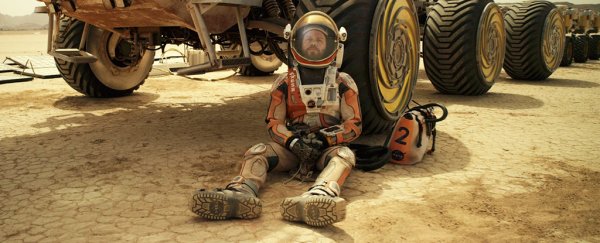The risk of cancer for astronauts heading to Mars could be double what we previously thought, according to a new model showing that cosmic radiation could have a knock-on effect through healthy cells.
The idea that cells damaged and mutated by space rays could then harm healthy 'bystander' cells not originally affected isn't taken into account by existing risk assessments, and now we're faced with yet another threat to potential Mars tourists.
A team from the University of Nevada, Las Vegas is calling for more detailed studies of the sort of health risks astronauts might face beyond the protection of Earth's magnetic shield, and how we might be able to counter it.
"Galactic cosmic ray exposure can devastate a cell's nucleus and cause mutations that can result in cancers," says lead researcher Francis Cucinotta.
"We learned the damaged cells send signals to the surrounding, unaffected cells and likely modify the tissues' microenvironments. Those signals seem to inspire the healthy cells to mutate, thereby causing additional tumours or cancers."
The researchers used a non-targeted effect model for cancerous growth to reaffirm something scientists first noticed in 1992 - the way cells not directly hit by radiation can still be affected by it.
We know cosmic rays can increase the risk of numerous health problems, including cancer and circulatory disease, thanks to their very high rates of ionisation. The threat they pose is one of the main issues with heading out of Earth's orbit.
Scientists still aren't exactly sure about the subsequent risks, but research is ongoing - it's one of the reasons NASA astronaut Scott Kelly spent almost a year in space, so we could understand more about the long-term effects.
More information was gleaned from the Mars Curiosity rover as it made its way to the Red Planet from November 2011 to August 2012. Scientists found that the equipment was exposed to a radiation dose up to 1,000 times higher than it would be on Earth.
What Cucinotta's team and other researchers are trying to find out now is how much damage that radiation could do, and what might be needed to stop it.
Existing tests haven't been long enough or thorough enough, they say.
"Exploring Mars will require missions of 900 days or longer and includes more than one year in deep space where exposures to all energies of galactic cosmic ray heavy ions are unavoidable," says Cucinotta.
"Current levels of radiation shielding would, at best, modestly decrease the exposure risks."
Obviously we don't want astronauts dying or getting ill on the way to Mars, but we also need to be sure that their cognitive abilities aren't damaged by the trip, as setting up and maintaining a lab on Mars is going to require a lot of brainpower.
Further studies are "urgently needed", before we launch any long-term space missions, the researchers say.
We already know radiation shielding will be crucial in getting safely to Mars, and living on the surface, but how much of it is required and how we engineer it is going to play a crucial role in the viability of future missions.
Those missions are still very much in the pipeline – but we need to make sure they're safe.
"Waving or increasing acceptable risk levels raises serious ethical flags, if the true nature of the risks are not sufficiently understood," says Cucinotta.
The research has been published in Scientific Reports.
